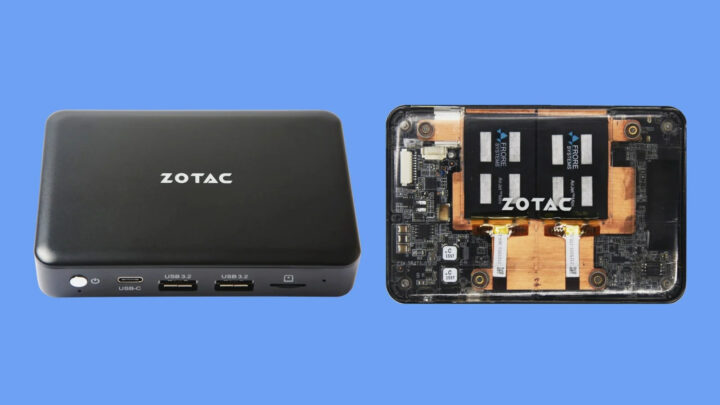ZOTAC PI430AJ Pico is the first mini PC equipped with (two) Airjet solid-state active cooling chips introduced at CES 2023, doing without the metal case required by typical fanless systems, and instead relying on a plastic case.
The PI430AJ Pico is powered by a recent 7W Intel Core i3-N300 octa-core Alder Lake-N processor coupled with up to 16GB LPDDR5 RAM and an M.2 NVMe SSD up to 1TB capacity. The mini PC is showcased at COMPUTEX 2023 with a transparent cover to showcase the two FRORE Systems Airjet mini PC, but it will eventually be sold with a black plastic enclosure.
ZOTAC PI430AJ Pico preliminary specifications:
- SoC – Intel Core i3-N300 octa-core processor up to 3.8 GHz with 6MB cache, 32EU Intel UHD Graphics Gen 12 @ 1.25 GHz; TDP: 7W
- System Memory – Up to 16GB LPDDR5
- Storage – Up to 1TB M.2 NVMe SSD, microSD card slot
- Video Output – HDMI 2.0 video output up to 4Kp60, DisplayPort
- Audio – 3.5mm audio jack, digital audio via HDMI and DisplayPort
- Networking – Gigabit Ethernet, WiFi 6 and Bluetooth 5.2.
- USB – 2x USB 3.2 ports, 1x USB Type-C port
- Misc – Power button
As a reminder, Frore Systems Airjet Mini and Airjet Pro are active cooling chips that are just 2.8mm thick and quietly suck cool air in from the top of the chip before pushing it out the sides with the aim to replace traditional fan-based solutions. It was initially designed for ultrabooks, but it has now found its way into a mini PC.
ZOTAC has made some ridiculously small and thin fanless mini PC in the past, and they do work, but they are usually configured with thermal limits to keep up with the heat dissipation, and the Airjet cooling chip will enable higher and more stable performance in such small devices while still being virtually quiet. PCWorld got a look at the ZOTAC PI430AJ Pico mini PC, and the presenter can only barely hear the chips when his ear is placed around 15 centimeters from the mini PC
ZOTAC expects to start selling the PI430AJ for $500 in Q4 2023. We don’t have the full specifications for the mini PC, but it looks like there may be a hundred dollars or so premium for integrating the Airjet chips into such a mini PC at this point in time, considering the actively-cooled Beelink EQ12 Pro sells for $349 with a similar Core i3-N305 processor, 16GB RAM, and a 500GB SSD.
Via PCMag

Jean-Luc started CNX Software in 2010 as a part-time endeavor, before quitting his job as a software engineering manager, and starting to write daily news, and reviews full time later in 2011.
Support CNX Software! Donate via cryptocurrencies, become a Patron on Patreon, or purchase goods on Amazon or Aliexpress





